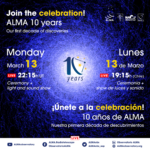ALMA and its Partners Celebrate 10 Years of Groundbreaking Science
March 13, 2023, marks the tenth anniversary of the Atacama Large Millimeter/submillimeter Array (ALMA), the world's largest radio telescope. Over the past decade, ALMA's partnership has revolutionized our understanding of the Universe by revealing new insights into the formation of planets, stars, and galaxies; deciphering the chemistry of the Cosmos; and has been a crucial component in obtaining the first images of black holes.
Streaming
To mark this milestone, ALMA is hosting a series of events during 2023, which kick off on March 13 at the observatory site near San Pedro de Atacama in Chile. On this day, ALMA representatives, Chilean authorities, ambassadors, and local communities will renew the "Tribute to Mother Earth" ceremony, performed by a local community leader, and tour the observatory facilities accompanied by scientists and engineers. The day will close with an immersive artistic performance of light and sound.
"ALMA has transformed our understanding of the Universe and opened new research frontiers," said Dr Sean Dougherty, Director of ALMA. "We are very proud of the accomplishments of the past decade and excited about the discoveries over the next ten years."
Since its inauguration in 2013, the astronomical community has produced more than 3,000 scientific publications using ALMA data, with groundbreaking discoveries ranging from forming planets and stars to detecting complex organic molecules in the Universe's early years. One of ALMA's best-known achievements was its contribution to the Event Horizon Telescope project, which captured the first image of a black hole in the center of the M87 galaxy and also the one in the center of the Milky Way.
ALMA's success is due to its cutting-edge technology developed through an international collaboration of 21 countries from North America, Europe, and East Asia. The telescope consists of 66 antennas, spread over 16 kilometers on the Chajnantor plateau of the Chilean Andes, 5,000 meters above sea level. A partnership of ESO, NAOJ, and NRAO operates ALMA, whose observations have provided valuable data to astronomers worldwide to answer some of the most fundamental questions about the Universe.
March 13, the ceremony to celebrate its 10th anniversary, and the light and sound art performance will be available to watch over streaming on ALMA Social Networks and website. A complete list of activities celebrating the first decade may be consulted on the ALMA website[link].
"We are thrilled to celebrate this milestone," said Dr. Dougherty. "ALMA has been a game-changer in astronomy, and we are excited to continue pushing the boundaries of our knowledge in the years to come."
Video
Additional Information
The Atacama Large Millimeter/submillimeter Array (ALMA), an international astronomy facility, is a partnership of the European Organization for Astronomical Research in the Southern Hemisphere (ESO), the U.S. National Science Foundation (NSF) and the National Institutes of Natural Sciences (NINS) of Japan in cooperation with the Republic of Chile. ALMA is funded by ESO on behalf of its Member States, by NSF in cooperation with the National Research Council of Canada (NRC) and the National Science and Technology Council (NSTC) in Taiwan and by NINS in cooperation with the Academia Sinica (AS) in Taiwan and the Korea Astronomy and Space Science Institute (KASI).
ALMA construction and operations are led by: ESO on behalf of its Member States; by the National Radio Astronomy Observatory (NRAO), managed by Associated Universities, Inc. (AUI), on behalf of North America; and by the National Astronomical Observatory of Japan (NAOJ) on behalf of East Asia. The Joint ALMA Observatory (JAO) provides the unified leadership and management of the construction, commissioning, and operation of ALMA.
Contacts
-
Nicolás Lira
Education and Public Outreach OfficerJoint ALMA Observatory, Santiago - ChilePhone: +56 2 2467 6519Cel: +56 9 9445 7726Email: [email protected]

